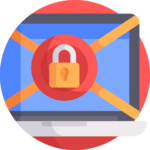My name is Lonnie, and I’m a victim of identity theft.
So check this out. A buddy of mine wrote a Facebook post about how someone stole his daughter’s Social Security number and filed for unemployment benefits with Washington State’s Employment Security Division (ESD). Having never occurred to me, I decided to go to ESD and attempt to file an unemployment claim. After I entered the information I received the following message:
The Social Security number (SSN) you entered already exists and is linked to this partly hidden email address: *****@fasternet.co
WHAT??!!??!? I’ve never filed an unemployment claim in my entire life, and I certainly have never used an email address at fasternet.co. Who the #$%^%! is this?
I read further and saw the following message:
If you think you might be a victim of unemployment imposter fraud – when criminals illegally apply for unemployment benefits using another person’s personal and employment information – report it! Use the form on the Employment Security Department (ESD) website. Then wait to hear from ESD.
I couldn’t believe it. I was for the first time in my life a victim of identity theft. And it wasn’t through the more traditional path of credit card or banking fraud; it was through unemployment benefits fraud.
As I navigated the what do you do about it path, I learned a lot about the prevalence of identity fraud and just how exposed I was. Experian, one of the three credit reporting companies, published some eye-popping statistics (all as of 2017).
- 158 million Social Security numbers exposed in data breaches
- 14.2 million credit card numbers exposed
- $905 million in total fraud losses
- 13,852 identity theft complaints affecting children and teens
- 60,000 complaints of mail theft
- 883,000 confirmed identity theft tax returns
- 27% of data breaches were medical or healthcare related
Identity theft is real. The bad guys are clever and only care about getting your money. The pain, frustration, and fear they leave in their wake means nothing to them. If you think it can’t happen to you then you’re living under a rock.
As a result of my experience, I decided to compile everything I did to check for fraud activity and the steps I took once I discovered unemployment benefits fraud occurred. Hopefully these are helpful to you as well.
- Review your credit report at annualcreditreport.com for rogue accounts. You can do this for free once a year. Don’t be lulled into a false sense of security if everything looks good. Things like unemployment benefits don’t show up on the report. You need to do more digging.
- Check to see if someone has used your SSN to file an unemployment claim. In the state of Washington go to ESD Secure Access Washington and follow the directions to create a Secure Access Washington account. This is how I found out someone filed unemployment benefits using my name and SSN.
- Request a Social Security Account Statement for any benefit claims against your SSN.
- Request an IRS Transcript for your tax filing history.
- Check if your personal information was included in the Equifax breach which occurred between May and July of 2017 that exposed the personal information of 140 million Americans. My SSN was one of the 140 million.
If there has been fraudulent activity, take the next steps:
- Go to Federal Trade Commission website Identitytheft.gov. The website walks you through steps to take depending on your situation.
- File a fraud report with your state. In Washington you file with ESD.
- File a police report with your local police department.
- File an IRS Identity Theft Affidavit.
- File an Equifax Fraud Alert. This lets credit card companies know you were a victim of identity theft. According to Equifax this puts additional checks in place to watch for fraudulent activity. They also notify Experian and Transunion of the theft. I cannot speak to whether it’s effective at this point but feel it couldn’t hurt to do it.
- If the theft was medical-related, file a health-privacy complaint with the US Department of Health & Human Services.
Regardless of whether you have fraudulent activity, I strongly recommend you do the following:
- Place a credit freeze on your report with Experian, Transunion, and Equifax. A credit freeze restricts access to your credit report. However, if you plan to apply for a credit card, bank account, or mortgage you need to unfreeze your credit with each of the bureaus then freeze it again after the inquiry has been made. A small inconvenience compared to someone opening a credit card in your name using your personal information.
- Set up mail or text alerts with your bank and credit card companies for any transactions with an amount greater than zero. The big financial services companies offer alert options that you can customize. You’ll get an alert any time the card is used, which some may find annoying, but again I’d rather delete a notification email or text than have someone run rampant with my credit card or bank account.
- Set up two-factor authentication on your accounts. Also referred to as two-step authentication, this enforces a second type of authentication in addition to a password (i.e. a text message, fingerprint, or email verification) if someone tries to log into one of your accounts.
- Use a crosscut shredder for any documents containing personal information. This also includes any credit card or financial services offers you may receive in the mail.
- If your state offers, establish an account that lets you register your SSN and access online services of multiple state agencies. In the state of Washington this is called Secure Access Washington. You may need to do some digging for your state but it’s worth it.
- Be cautious about using public WIFI; consider using a Virtual Private Network (VPN) if you access sensitive personal information on public networks.
- Make sure you also review accounts for a loved one, spouse, partner, and children.
Identity theft is real, and it can happen to you. The bad guys will never go away, but you can make it more difficult for them by putting some preventative measures in place to protect you and your loved ones from identity theft.
Note: If you would like the hyperlinks to all bold references go here.






